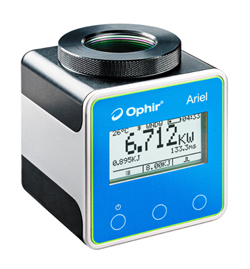INDUSTRY INSIGHTS
Opto Diode's UVG photodiodes and OD-800 LEDs deliver high stability, radiation resistance, and precision for demanding space and astronomy missions in extreme environments.
- Miniature Piezo Stages With Bi-Phase Inertia Motors
- High-Performance Photodetectors For Advanced Microscopy
- Limitations Of Spectral Measurements
- Are You Making These 3 Optical Filter Mistakes?
- We're An Optical Engineer's Best Friend
- Key Factors That Determine Laser Damage Threshold
- Custom vs Catalog Semrock Optical Filter Options
- Custom Microscope Objective Case Study
- Furnace Monitoring
LATEST HEADLINES
- Laser Photonics Subsidiary Beamer Secures New Orders From Leading Manufacturers In Illinois, Michigan
- Scientists Uncovers An Exciting Use Of Teak Leaf Which Offers A Natural, Biodegradable Laser Shield Towards Protecting Delicate Optical Devices And Human Eyes From High-Power Laser Radiation
- Laser Photonics Supplies Laser Cleaning And Marking Tools To Petroleum Industry
- Solar Cells: Back To The Basics, Forward To The Future
- Innovation Project To Provide 4-inch Aluminum Nitride Crystals For Future Markets In Power Electronics And UV Photonics
FEATURED SOLUTIONS
-
Linear Actuators For Micropositioning And Precision Alignment
For applications demanding sub-micrometer precision—such as fine positioning, alignment, or adjustment—PI’s M-235, L-220, and M-230 linear actuator series provide reliable, high-performance motion control.
-
High-Performance Quadrant Photodiode: AXUVPS7
The AXUVPS7 from Opto Diode is a high-performance quadrant photodiode designed for precise measurement of both electrons and photons over a broad spectral range.
-
Mini SWIR JSX Snapshot Camera - 30 FPS
The Mini-SWIR™ JSX Snapshot Camera (GA1280JSX) is a compact, high-performance imaging solution designed for real-time surveillance and imaging in both daylight and low-light conditions.
-
Blue/Green Enhanced 6 mm2 Photodiode-Preamplifier: ODA-6WB-500M
The Opto Diode ODA-6WB-500M is a blue/green-enhanced photodiode-preamplifier designed for precision optical detection across a range of low-light applications.
-
SWIR Lenses
SWIR lenses, short for Short-Wave Infrared lenses, are specifically designed for industrial imaging applications that operate in the short-wave infrared spectrum.
FEATURED VIDEOS
-
5-Axis Wafer Stage, Air Bearing Motion System
PI's high-performance 5-axis nanopositioning air bearing system offers precision motion control in semiconductor wafer processing, ideal for front-end/back-end processes, utilizing advanced motion controllers.
-
Growing And Packaging Crystal Optics
Toby Reid of G&H explores the benefits of vertical integration in growing and packaging crystal optics.
-
New IR Coating Chamber And Website Launch
Mike Tiner from Andover Corporation discusses the launch of a new IR coating chamber and the debut of a redesigned website.
FEATURED WEBINARS
-
From Photons To Nuclear Fusion: How To Measure Energy In Any Laser System?
In this webinar, you will learn how to measure laser energy accurately. You will also discover the tools that can help you maintain standardized quality and ensure end-users’ safety, therefore ensuring the success of your operations.
-
Mx™ 9.2 Highlights: Get The Most Out Of Your Metrology Software
Discover the latest advancements in measurement technology with Zygo experts. Explore Version 9.2 of Zygo Mx™ Software and delve into automated metrology, advanced analysis, and quality enhancements.
-
Unlocking The Future Of Low-SWaP Thermal Imaging: Design Challenges And Performance
This presentation discusses the performance and design challenges of advanced folded optics and lightweight zoom lenses optimized for next generation IR thermal imaging systems and applications.
FROM THE EDITOR
- What's The Deal With Translucent Concrete?
- How Fiber Optics Are Transforming Internet Speed, Reliability, And Security
- The Laser Arsenal: The Military's New Speed-of-Light Defense Systems
- The Future of Photonics: What to Expect at SPIE Optics + Photonics 2025
- How Photonics Are Used In The Manufacturing Of Sporting Goods
RECENT NEWSLETTERS
- 07.02.25 -- 14 Must-See Solutions, From SWIR Linescan Cameras To Edge Blackened Optical Filters
- 06.30.25 -- Hyperspectral Imaging In Forensic Investigations, Imaging Systems Perseverance & More
- 06.25.25 -- High-Performance Photonics For Space And Astronomy
- 06.23.25 -- Quantum Sensing's New Dawn For Photonics, Building A Do-It-Yourself Quantum Scanning Microscope & More
- 06.18.25 -- Fiber Optic Cables: How Far Is Too Far?
SPECIAL FEATURE
Ultra-Compact Laser Power Meter For High Power Industrial Lasers In Confined Spaces: Ophir® Ariel
Ophir offers the new Ophir® Ariel, a self-contained, ultra-compact laser power meter for measuring high-power industrial lasers up to 8KW. Read more.
SUPPLIER OF THE MONTH
Zygo Corporation is a global leader in the design and manufacture of advanced optical metrology systems and ultra-precise optical components and assemblies. Our mission is to enable customer success by delivering innovative precision optical and metrology solutions that exceed expectations. Learn More


















